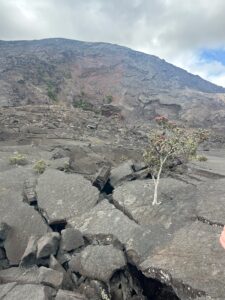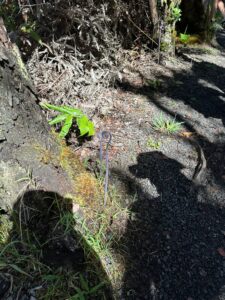By Mac Malambri
I awoke to chirping birds, crocking frogs, and the panic of realizing that everyone in my room had left. My professor told us we would have an early start today, but didn’t specify how early. Had all the other guys left without waking me up? Fortunately, no. They went for a sunrise swim. I had an hour and a half before our “early”—AM—departure.
After a quick breakfast, we departed for the Hawaiian Volcanos National Park. Hawaiian Volcanos National Park is home to the volcanic crater on Kiluaea. This crater is home to Pelé in traditional Hawaiian religion. Pele is the Godess of fire, lava, eruptions, and really everything related to volcanos. She must be appeased to avoid tragic eruptions. Historians can actually use the legends about Pele and her eruptions to understand eruptions prior to European arrival. The crater first erupted in 1959. The primary fissure quickly formed from multiple smaller fissures. It shot up 1900 ft above the fissure. The fissure provided geologists an opportunity to understand how lava solidifies into rock. We ventured into the crater. It was incredible. It was huge. It was mostly flat, but consisted of what looked like upside-down plates that meet at joints. There were small plants that had grown on the rock, but it was largely barren. Dominating the crater was a huge tower of rock where the fissure once stood. When the fissure erupted, it filled the crater, creating an immense lava lake. It slowly solidified with the surface rock solidifying in plates that appeared like miniature tectonic plates before they sank, being denser than the surrounding lava. This process continued until eventually a surface solidified over more solid rock and could not sink. Before it solidified, there were waves of hot lava traveling across this lava lake. There are photos from the eruption, but I having stood in the crater, I can tell that these photos do not capture the immense beauty that must have radiated from a scene in Dante’s inferno present on earth.





Once we hiked out of the crater, we entered a lava tube. When lava is flowing, it can have difference in temperatures. This can result in some lava solidifying around still liquid lava. Once this liquid lava drains, it leaves a tube. They are so cool and so dark. I made the bold choice to not bring a head lamp or phone. It was just light enough that I was alright, but I was a little nervous being the tallest person in the group. We think drove to the visitors center/Volcano Hotel. The visitors center had some beautiful art. It was a great place to have lunch. Unfortunately, the humidity of Hawaii is not great for our bread which was moldy. After the visitors center, we walked to the Volcano Hotel. It overlooks the Kiluaea caldera which is just incredible. I got to the overlook and sat in one of the rocking chairs before our lesson on this feature. Once the lesson ended, it took all my willpower to wish the comfort of that chair and beauty of the caldera goodbye.

After the caldera, we went to the sulfur banks. The primary mineral in the rocks that come from volcanos is silica. Though Hawaiian basalts have unusually low silica content, resulting in their generally less explosive nature, they still have silica. Near the volcano, silica escapes the volcano through small fractures. These sulfur banks smell like sulfur. You can find them near many volcanos, including Yellowstone and—of course—Kilauea. Personally, I think that the sulfur smell is not that strong and it feels so nice to have the humid air blow over your face, but most people shunned it. There is a boardwalk that allows us to see the sulfur banks, despite the unstable ground. The heat from the evaporating sulfur warms the ground to around 200 degrees Fahrenheit. In the 90s, a boy stepped off the boardwalk and fell several feet. He endured charred skin from his chest through his legs from mere seconds in contact with the hot ground. If you think about how hot a black sidewalk is on a sunny day in summer, the rocks around the sulfur banks would be twice that temperature.

We finished the day with a tour of rainbow falls. It is on the first river we encountered on the island. In areas formed by newer flows, such as those surrounding Kilauea and Mauna Loa, there has not been enough time for the rock to erode into rivers, but further northwest, rivers form on the old flows of Mauna Kea. Rainbow falls were cool, but much cooler were the trees we encountered. These trees appear like a bunch of tiny vines that form webs that become trees. It is erre. Van—who is Vietnamese—told us that Vietnam, these trees are supposedly home to those who are trapped on earth after death. There, you avoid those trees at night.


We finished the day with some ocean kayaking and spaghetti night. It was really good. We watched Teen Beach Movie, in keeping with music we had listened in the car the day before. Overall, this has been my favorite day so far.
